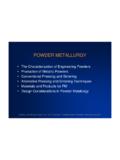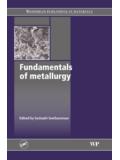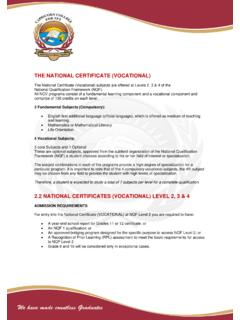Transcription of Chapter 2, Fundamentals of Iron and Steelmaking
1 There have been tremendous improvements in iron and Steelmaking processes in the past twenty and coke rates in the blast furnace and the ability to refine steel to demanding specifica-tions have been improved significantly. Much of this improvement is based on the application of fun-damental principles and thermodynamic and kinetic parameters which have been , many future improvements will be forthcoming in Steelmaking equipment, process improve-ments resulting from the application of fundamental principles and data will likewise this Chapter the basic principles of thermodynamics and kinetics are reviewed and the relevantthermodynamic data and properties of gases, metals and slags relevant to iron and Steelmaking arepresented.
2 These principles and data are then applied to ironmaking, Steelmaking and secondaryrefining processes. These principles and data are also used in subsequent chapters in this writing this Chapter , an attempt has been made to limit the discussion to an average level suit-able for the students of metallurgy pursuing graduate or post-graduate education as well as forthose with some scientific background engaged in the iron and steel industry. It is assumed that thereader has some basic knowledge of chemistry, physics and mathematics, so that the Chapter canbe devoted solely to the discussion of the chemistry of the . GasA gas which obeys the simple gas laws is called an ideal gas satisfying the following relation:PV=nRT( )where n is the number of mols and R the universal molar gas one mol of an ideal gas at and l atm pressure, the value of the molar gas constant is:For pressure in Pa ( Nm 2 Jm 3) and volume in m3,R= = J mol =1 l atm mol K -1-122 414273 16 Chapter 2 Fundamentals of iron and Turkdogan, Consultant: Pyrometallurgy & Fruehan, Professor, Carnegie Mellon UniversityCopyright 1999, The AISE Steel Foundation, Pittsburgh, PA.
3 All rights Volume38 Copyright 1999, The AISE Steel Foundation, Pittsburgh, PA. All rights a gas mixture containing n1, n2, number of mols of gases occupying a volume V at a totalpressure P, the partial pressures of the constituent gaseous species are as given below. ( )P = p1+ p2+ p3+ ..( )The following equations are for a given mass of gas at constant pressure, volume and temperature:Constant pressure (isobaric)( )Constant volume (isochoric)( )Constant temperature (isothermal)P1V1= P2V2= ( )Generally speaking, deviation from the ideal gas equation becomes noticeable with easily liquefi-able gases and at low temperatures and high pressures. The behavior of gases becomes more idealwith decreasing pressure and increasing temperature.
4 The nonideality of gases, the extent of whichdepends on the nature of the gas, temperature and pressure, is attributed to two major causes: (1)van der Waals forces and (2) chemical interaction between the different species of gas molecules .1. 2 Thermodynamic First LawThe first law of thermodynamics is based on the concept of conservation of energy. When there isinteraction between systems, the gain of energy of one of the systems is equal to the loss of theother system. For example, the quantity of heat required to decompose a compound into its ele-ments is equal to the heat generated when that compound is formed from its.
5 1. 2 . (heat content)The internal energy of a system includes all forms of energy otherthan the kinetic energy. Any exchange of energy between a system and its surroundings, resultingfrom a change of state, is manifested as heat and a system expands against a constant external pressure P, resulting in an increase of volume V, the work done by the system isw = P V = P(VB VA)Since this work is done by the system against the surroundings, the system absorbs a quantity ofheat q and the energy E of the system increases in passing from state A to state B. E = EB EA= q P V = q P(VB VA)Upon re-arranging this equation, we have(EB+ PVB) (EA+ PVA) = qThe quantity E + PV is represented by a single symbol H, thus H = q = (EB+ PVB) (EA+ PVA)( )The function H is known as enthalpy or heat are two fundamental thermochemical laws which express the first law specifically in terms ofenthalpy.
6 The first principle derived by Lavoisier and Laplace (1780) states that the quantity of heatrequired to decompose a compound into its elements is equal to the heat evolved when that com-pound is formed from its elements ; the heat of decomposition of a compound is numericallyPTPTPT 112233==LVTVTVT112233==L pnP11=n + n + n + 123K Fundamentals of iron and Steelmaking39equal to its heat of formation, but of opposite sign. The second principle is that discovered by Hess(1840); it states that the heat of reaction depends only on the initial and final states, and not on theintermediate states through which the system may pass. Heat CapacityThe heat capacity of a substance is defined as the quantity of heat required toraise the temperature by one degree.
7 The heat capacity of 1 g of a substance is called the specificheat. The heat capacity of 1 g-molecule (abbreviated as mol) is called the molar heat variation of energy, at constant volume, and of enthalpy, at constant pressure, with tempera-ture gives the heat capacity of the system, thus( )( )For an ideal gas the difference between the molar heat capacities at constant pressure, Cp, and con-stant volume, CV, is equal to the molar gas CV= R( )Because of experimental convenience, the heat capacity is determined under conditions of constantpressure (usually atmospheric).From the temperature dependence of heat capacity at constant pressure, the enthalpy change isobtained by integrating equation ( )Above 298 K, the temperature dependence of Cpis represented by:Cp= a + bT cT 2( )( )where the coefficients, a, b and c are derived from Cp calorimetric measurements at different recent compilations of thermochemical data, the H values are tabulated at 100 K intervals forthe convenience of StateThe enthalpy is an extensive property of the system, and only the changein heat content with change of state can be measured.
8 A standard reference state is chosen foreach element so that any change in the heat content of the element is referred to its standardstate, and this change is denoted by H .The natural state of elements at 25 C and 1 atm pressure is by convention taken to be the referencestate. On this definition, the elements in their standard states have zero heat heat of formation of a compound is the heat absorbed or evolved in the formation of 1 g-molof the compound from its constituent elements in their standard states, denoted by H of ReactionThe change of enthalpy accompanying a reaction is given by the dif-ference between the enthalpies of the products and those of the reactants.
9 Ha bT cTT=+ () 2298dT = 2112ooC dT p Cp= p CET VV= Ironmaking Volume40 Copyright 1999, The AISE Steel Foundation, Pittsburgh, PA. All rights an isobaric and isothermal reaction,A + B = C + D( )the enthalpy change is given by: H = ( H C + H D) ( H A + H B)( )By convention, H is positive (+) for endothermic reactions, heat absorption, and H is negative ( ) for exothermic reactions, heat effect:( )( )The following are some examples of the special terms of the heat of or heat of formationFe + 1 2O2 FeOHeat of combustionC + O2 CO2 Heat of decomposition2CO C + CO2 Heat of calcinationCaCO3 CaO + CO2 Heat of fusion (melting)Solid LiquidHeat of sublimationSolid VaporHeat of vaporizationLiquid VaporHeat of solutionSi(l) [Si] (dissolved in Fe) Adiabatic ReactionsWhen a reaction occurs in a thermally insulated system, no heatexchange between the system and its surroundings, the temperature of the system will change inaccordance with the heat of an example, let us consider the internal oxidation of unpassivated direct reduced iron (DRI)
10 Ina stockpile, initially at 25 C. The enthalpy of reaction at 298K is( )The heat balance calculation is made for 1000 kg Fe in the stockpile with 150 kg FeO formed inoxidation. The heat absorbed by the stockpile is 150 103/72 267 kJ and the temperature rise iscalculated as follows:Q=[nFe(Cp)Fe+ nFe O(Cp)Fe O](T 298)nFe=17,905 g-mol for 1000 kg FenFe O= g-mol for 150 kg FeOCp (Fe)= kJ mol 1K 1Cp (FeO)= kJ mol 1K 1 Q = 557,416 = (752 + 123) (T 298)With this adiabatic reaction, the stockpile temperature increases to T = 935K (662 C).The moisture in the stockpile will react with iron and generate H2which will ignite at the elevatedstockpile temperature. This has been known to happen when DRI briquettes were not adequatelypassivated against The Second LawThe law of dissipation of energy states that all natural processes occurring without external inter-ference are spontaneous (irreversible processes).




